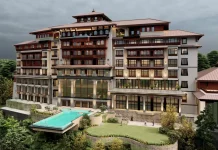Surfing in Huntington Beach
The endless summer lives in Huntington Beach. Southern California’s beach culture thrives along this city’s curving shoreline. We spotted families, friends and individuals spending the afternoon cycling down an oceanfront path, playing volleyball, and, of course, surfing.
Surfing definitely sets the tone in Huntington Beach, and so, that’s just what we did! We grabbed a few boards and rode the waves all afternoon near
the Huntington Pier. Later in the evening, you can rent a few bikes and cycle along the ocean-hugging boardwark.
Rock climbing in Joshua Tree National Park
Joshua Tree is a belt-notch on many a rock-climber’s belt, and a great place to try the sport. More than 8,000 established climbing routes present diverse challenges, ranging from easy beginner slabs and boulders to extreme vertical cracks, especially near the Hidden Valley and Ryan campgrounds, and at the vast Wonderland of Rocks. Believe me, it is a heaven for outdoor lovers! And there is also has an interesting history behind those signature boulders.
![Joshua Tree National Park is located in southeastern California. Declared a U.S. National Park in 1994 when the U.S. Congress passed the California Desert Protection Act (Public Law 103-433), it had previously been a U.S. National Monument since 1936. It is named for the Joshua tree (Yucca brevifolia) forests native to the park. It covers a land area of 790,636 acres (1,235.37 sq mi; 3,199.59 km2)[1] – an area slightly larger than the state of Rhode Island. A large part of the park, some 429,690 acres (173,890 ha), is a designated wilderness area. Straddling the San Bernardino County/Riverside County border, the park includes parts of two deserts, each an ecosystem whose characteristics are determined primarily by elevation: the higher Mojave Desert and lower Colorado Desert. The Little San Bernardino Mountains run through the southwest edge of the park](http://www.ritzmagazine.in/testing/wp-content/uploads/2016/06/Joshua-Tree-National-Park.jpg)
More than 100 million years ago, a seismic activity from the San Andreas Fault forced molten liquid upward from the earth’s crust which cooled and hardened below the earth’s surface. Over time, flash floods washed away layers of dirt and exposed towers, domes, and spires of monzogranite, creating an otherworldly landscape that now is a playground for climbers.
Horseback Riding at June Lake Loop
Here’s an outstanding drive through ultimate alpine scenery. From Mammoth Lakes, head north on U.S. 395 to State 158, then head west towards the hamlet of June Lake. For roughly 15 miles, the road winds past a series of sparkling glacial lakes, all encircled by snaggletooth peaks that scrape the skies. Pull over and just breathe it in for a while: scenes don’t get much lovelier than this, especially in fall when aspen leaves paint the lower hillsides and shorelines gold. Stick around to enjoy activities offered here, including fishing, hiking, and horseback riding. June Lake has canoes, standup paddleboards, and other watercraft for rent too. If all that activities makes you a little sore, no worries—get a massage at the inviting Double Eagle Resort.
Hiking and camping at Lake Arrowhead
The drive from San Bernardino to Lake Arrowhead is pretty short. But as you drive from the busy valley into the San Bernardino Mountains, and arrive at this picturesque town set on a deep-blue mountain lake, you will feel like you have escaped to a different world! No wonder this lake has long been the favored escape for those seeking exclusive alpine luxury. The lake and much of its shoreline are privately owned—with gated lakeside vacation homes to prove it (but you don’t need the keys to a gated estate to visit). Pitched a tent at a campground, and head out on the Pacific Crest Trail that lace through surrounding forestlands. It is also one of America’s longest scenic hiking trails, running all the way from Mexico to Canada! If camping isn’t your thing, you can also relax in rustic rental cabins, many are available and include dock and lake privileges.
Beach Camping at Pismo Beach
Reserve a spot for your tent at appealing (and popular) Spooner Cove. Or consider North Beach State Campground, about 14 miles south of SLO in Pismo Beach; romp on more than 20 miles of unspoiled sandy beaches, and find your perfect spot for digging legendary Pismo clams (permit required; see link below for details). Pismo State Beach is also known for its remarkable Monarch Butterfly Grove, where tens of thousands of the elegant, black-and-orange butterflies stop to rest during their annual migration. Spotting scopes are set up for easy viewing of the butterflies, which hang from trees in tight clusters in the evening to help stay warm through the night. In the morning, watch them flutter and fly as the sun coaxes them awake.
Whale Watching Near San Francisco
If you want to see whales, head to the tip of Point Reyes National Seashore from December through February. According to whale experts, an astounding 94 percent of migrating Pacific gray whales pass within 1 mile/1.6 kilometres of this protected peninsula some 27 miles/43 km north of San Francisco. January is the most whale-happy month, when more than 1,000 whales can pass this point each day. Access to the tip of Point Reyes is controlled during peak season (December through March), with bus shuttles running between parking lots and prime viewing areas. Other watch-from-shore hot spots include the headlands in Montara and Half Moon Bay (both less than 45 minutes drive south of San Francisco). Or just head out to any high spot along the coast that juts into the Pacific. Calm days without whitecaps are best—that’s when it’s easiest to spot the whales’ telltale spouts.
Yosemite High Sierra Camps
Here’s a glamping experience like no other—one that requires some work to enjoy, but worth every ounce of effort. The work comes in the form of hiking or horse-packing to one or more of the five camps, open June through early September. Each camp is roughly 6 to 10 miles/9 to 16 kilometers apart; all are strung along the 49-mile/79-km High Sierra Camp Loop trail. But once you’ve arrived, the scenery—some of Yosemite National Park’s most spectacular high country around Tuolume Meadows—will make it all worth it.
![Yosemite National Park (/joʊˈsɛmɨtiː/ yoh-sem-it-ee) is a United States National Park spanning eastern portions of Tuolumne, Mariposa and Madera counties in the central eastern portion of the U.S. state of California. The park, which is managed by the National Park Service, covers an area of 761,268 acres (3,080.74 km2)[2] and reaches across the western slopes of the Sierra Nevada mountain chain.[4] Over 3.7 million people visit Yosemite each year: most spend their time in the seven square miles (18 km2) of Yosemite Valley.[5] Designated a World Heritage Site in 1984, Yosemite is internationally recognized for its spectacular granite cliffs, waterfalls, clear streams, Giant Sequoia groves, and biological diversity. Almost 95% of the park is designated wilderness. Yosemite was central to the development of the national park idea. First, Galen Clark and others lobbied to protect Yosemite Valley from development, ultimately leading to President Abraham Lincoln signing the Yosemite Grant in 1864. Later, John Muir led a successful movement to establish a larger national park encompassing not just the valley, but surrounding mountains and forests as well - paving the way for the United States national park system](http://www.ritzmagazine.in/testing/wp-content/uploads/2016/06/Yosemite-NP-11.jpg)
Plus, your fully outfitted cabin tent, complete with woodstove to ward off the chill at the 9,000-foot/2,743-meter elevation, means you’ll only have to pack in your personal items and toiletries. During your stay, enjoy hot dinner and breakfast, served family style with other guests—a great time to swap stories and hiking tips. Sack lunches for trailside picnics can also be ordered in advance.
Natural Hot Springs in Mammoth
With its regal mountain majesty and alpine hush, it’s hard to imagine that Mammoth Lakes is situated on the edge of an ancient volcanic caldera. Here, some 760,000 years ago, a massive volcano exploded, leaving behind the relatively flat basin now cradling Mammoth Lakes. A wonderful byproduct of this fiery past is the region’s network of natural hot springs. Many of these bubbling hot tubs, some open for safe dipping, are concentrated between Bridgeport and Mammoth Lakes, but finding them requires a bit of a treasure hunt—ask for directions from the Mammoth Lakes Welcome Center, just west of U.S. 395 on 2510 Main St. And no matter where you dip, use caution—surfaces can be slippery, and if the water feels uncomfortably warm, come back another day
Cycling around in Davis
Eco-friendly, liberal leaning, progressive, impressive professor’s homes and fraternity houses—Davis has the hallmarks of a classic American college town. But it’s got its own vibe too—thanks in large part to its flat topography and fertile setting. Started as the agricultural extension for University of California, Berkeley, UC Davis soon became its own campus, with strong veterinary, viticulture and agricultural departments.
It makes the town a haven for bicycles—it’s said there are more bikes than people here, and the town is home to the U.S. Bicycling Hall of Fame, with memorabilia and gear from top racers and events. Hire a bike to follow some 100 miles of bike lanes and paved paths: loop through the lush UC Davis Arboretum, then pedal to town along streets lined with shops, galleries and restaurants serving world cuisine. Time your visit to coincide with the twice-weekly farmers market, or to catch a performance at the soaring Mondavi Center for the Performing Arts.
Kayaking the Channel Islands
The kayaking opportunities at the Channel Islands are some of the best anywhere in California. Visitors can kayak on their own or go with a park-authorized outfitter. Anacapa and Santa Cruz are the most popular islands for kayaking, with hundreds of sea caves to explore. At the top of most paddlers’ lists is a trip to Santa Cruz Island’s Painted Cave, one of the largest sea caves in the world. It is almost 100 feet wide/30.5 meters and extends 1,215 feet/370 meters into the west end of Santa Cruz.
Most outfitters lead tours to Painted Cave, and even paddling novices can make the trip (but expect to have sore triceps the next day). Kayakers put in at Scorpion Anchorage, then paddle around the island to Painted Cave, visiting smaller sea caves along the way. If you don’t want to paddle that far, some companies drop anchor closer to the cave. Once you travel through Painted Cave’s yawning mouth, you’ll find it’s pitch black inside, but there’s life all around you. Seals and sea lions protest your arrival with a ruckus of barking. Hundreds of seabirds roost in the damp alcoves. Remember to pack a good headlamp to light up the multi-hued cave walls, with colors caused by lichen and minerals.
















